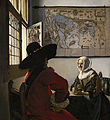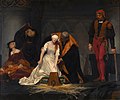
Hans Memling was a German-Flemish painter who worked in the tradition of Early Netherlandish painting. Born in the Middle Rhine region, he probably spent his childhood in Mainz. During his apprenticeship as a painter he moved to the Netherlands and spent time in the Brussels workshop of Rogier van der Weyden. In 1465 he was made a citizen of Bruges, where he became one of the leading artists and the master of a large workshop. A tax document from 1480 lists him among the wealthiest citizens. Memling's religious works often incorporated donor portraits of the clergymen, aristocrats, and burghers who were his patrons. These portraits built upon the styles which Memling learned in his youth.

Antonello da Messina, properly Antonello di Giovanni di Antonio, but also called Antonello degli Antoni and Anglicized as Anthony of Messina, was an Italian painter from Messina, active during the Italian Early Renaissance.

A vase is an open container. It can be made from a number of materials, such as ceramics, glass, non-rusting metals, such as aluminium, brass, bronze, or stainless steel. Even wood has been used to make vases, either by using tree species that naturally resist rot, such as teak, or by applying a protective coating to conventional wood or plastic. Vases are often decorated, and they are often used to hold cut flowers. Vases come in different sizes to support whatever flower is being held or kept in place.

Ormolu is the gilding technique of applying finely ground, high-carat gold–mercury amalgam to an object of bronze, and objects finished in this way. The mercury is driven off in a kiln, leaving behind a gold coating. The French refer to this technique as "bronze doré"; in English, it is known as "gilt bronze". Around 1830, legislation in France outlawed the use of mercury for health reasons, though use continued to the 1900s.

The Waterloo Vase is a 15-foot (4.6 m) stone urn, situated in the garden of Buckingham Palace in central London. Fashioned from a single piece of Carrara marble, it was initially presented to Napoleon I, who intended to have it carved in celebration of anticipated future military victories. After the Emperor’s defeat at the Battle of Waterloo, the uncarved vase was given to the Prince Regent, later George IV. The Prince commissioned the sculptor, Richard Westmacott to decorate the vase with reliefs celebrating the victory at Waterloo. The original plan to place the vase in the Waterloo Gallery at Windsor Castle proved unrealisable, the weight of the vase being greater than the gallery’s floors could bear. It was therefore given to the National Gallery in Trafalgar Square. Considering the vase surplus to its requirements, the gallery placed it first in Hyde Park, London and then into storage at the Victoria and Albert Museum. In 1903, it was offered by the museum to the new king, Edward VII, who installed it as a garden ornament in the grounds of Buckingham Palace, where it remains. The vase is a Grade I listed structure.

Petrus Christus was an Early Netherlandish painter active in Bruges from 1444, where, along with Hans Memling, he became the leading painter after the death of Jan van Eyck. He was influenced by van Eyck and Rogier van der Weyden and is noted for his innovations with linear perspective and a meticulous technique which seems derived from miniatures and manuscript illumination. Today, some 30 works are confidently attributed to him. The best known include the Portrait of a Carthusian (1446) and Portrait of a Young Girl ; both are highly innovative in the presentation of the figure against detailed, rather than flat, backgrounds.
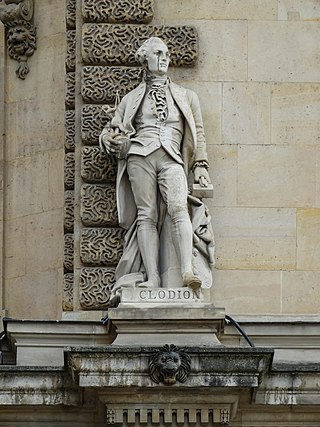
Claude Michel, known as Clodion, was a French sculptor in the Rococo style, especially noted for his works in marble, bronze, & terracotta.

Dieric Bouts was an Early Netherlandish painter. Bouts may have studied under Rogier van der Weyden, and his work was influenced by van der Weyden and Jan van Eyck. He worked in Leuven from 1457 until his death in 1475.

Joseph Erhardy was an American sculptor.
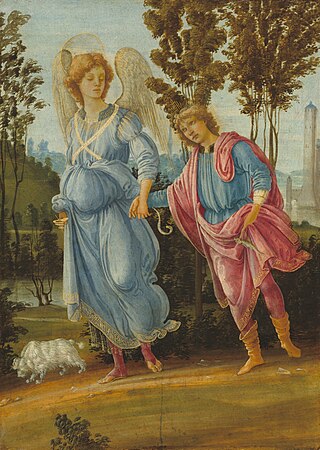
Tobias and the Angel is an oil and tempera painting on poplar panel by the Florentine Renaissance painter Filippino Lippi, dating from c. 1475–1480, of Tobias and the Angel, a popular subject at the time. It is now in the National Gallery of Art in Washington, DC.

Pierre-Philippe Thomire (1751–1843) a French sculptor, was the most prominent bronzier, or producer of ornamental patinated and gilt-bronze objects and furniture mounts of the First French Empire. His fashionable neoclassical and Empire style furnishing bronzes established the highest standard in refined finish in the craft that the French called that of the fondeur-ciseleur, "founder-finisher". In his pre-Revolutionary training, Thomire appeared first as a ciseleur, in the division of duties that went into the production, for example, of a set of gilt-bronze wall-lights delivered for Marie-Antoinette's card-room, her Salon des Jeux at Compiègne: under the general supervision of Hauré, the wax and wooden model was carved by Martin, cast by Forestier, and chased by Thomire, as Pierre Verlet was able to show over fifty years ago.

Count Anatoly Nikolaievich Demidov, 1st Prince of San Donato was a Russian industrialist, diplomat and arts patron of the Demidov family.

Biagio d’Antonio Tucci was an Italian Renaissance painter active in Florence, Faenza and Rome.

Count Pavel Pavlovich Demidov, 2nd Prince of San Donato was a Russian industrialist, jurist, philanthropist and nobleman of the House of Demidov. He was the only child of Finnish philanthropist Aurora Karamzin and Prince Pavel Nikolaievich Demidov.

The Andrew Jackson Downing Urn, also known as the Downing Urn, is a memorial and public artwork located in the Enid A. Haupt Garden of the Smithsonian Institution on the National Mall in Washington, D.C.

The Master of the Prado Adoration of the Magi was a Netherlandish painter active between c. 1475 and 1500 whose identity is now lost. He is thought to have originated from the southern Netherlands and is known for his vibrant colourisation in panels depicting scenes from the infancy of Christ, he is thought to have been a pupil of Rogier van der Weyden, and is named after a copy of the "Adoration of the Magi" panel from that painter's St Columba Altarpiece. Although the Magi became a popular topic for northern painters in the second half of the 15th century and the Columba altarpiece was widely copied, the master is associated with van der Weyden's workshop because the copy is so close, it is believed he must have had access to a reproduction of the underdrawing.

Portrait of Maria Portinari is a small c. 1470–72 painting by Hans Memling in tempera and oil on oak panel. It portrays Maria Maddalena Baroncelli, about whom very little is known. She is about 14 years old, and depicted shortly before her wedding to the Italian banker, Tommaso Portinari. Maria is dressed in the height of late fifteenth-century fashion, with a long black hennin with a transparent veil and an elaborate jewel-studded necklace. Her headdress is similar and a necklace identical to those in her depiction in Hugo van der Goes's later Portinari Altarpiece, a painting that may have been partly based on Memling's portrait.

Portrait of Tommaso Portinari by Hans Memling is held by the Metropolitan Museum of Art, New York City. It was made c.1470 in oil on oak panel, and measures 44.1 by 33.7 centimetres. The painting and Memling's Portrait of Maria Portinari form the wings from a since dismantled triptych; the central panel is believed to have been a now lost depiction of the Madonna and Child; perhaps Memling's Virgin and Child in the National Gallery, London.
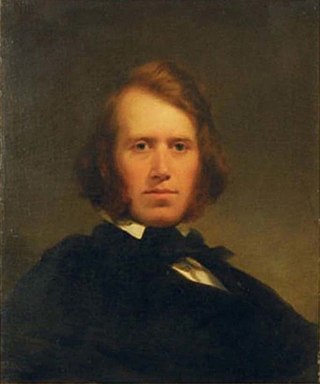
Horatio Stone, was an American sculptor, physician, and writer. He is best remembered for his three statues in the U.S. Capitol.








